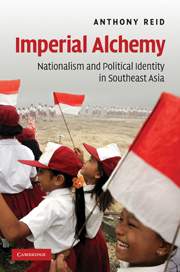Book contents
- Frontmatter
- Contents
- List of maps
- List of figures
- List of tables
- Acknowledgements
- Abbreviations
- 1 Nationalism and Asia
- 2 Understanding Southeast Asian nationalisms
- 3 Chinese as a Southeast Asian ‘other’
- 4 Malay (Melayu) and its descendants: multiple meanings of a porous category
- 5 Aceh: memories of monarchy
- 6 Sumatran Bataks: from statelessness to Indonesian diaspora
- 7 Lateforming ethnie in Malaysia: Kadazan or Dusun
- 8 Imperial alchemy–revolutionary dreams
- Glossary
- References
- Index
4 - Malay (Melayu) and its descendants: multiple meanings of a porous category
Published online by Cambridge University Press: 01 April 2010
- Frontmatter
- Contents
- List of maps
- List of figures
- List of tables
- Acknowledgements
- Abbreviations
- 1 Nationalism and Asia
- 2 Understanding Southeast Asian nationalisms
- 3 Chinese as a Southeast Asian ‘other’
- 4 Malay (Melayu) and its descendants: multiple meanings of a porous category
- 5 Aceh: memories of monarchy
- 6 Sumatran Bataks: from statelessness to Indonesian diaspora
- 7 Lateforming ethnie in Malaysia: Kadazan or Dusun
- 8 Imperial alchemy–revolutionary dreams
- Glossary
- References
- Index
Summary
Melayu is an ancient term, which has served multiple roles in its long career. It entered European languages in the sixteenth and early seventeenth centuries as Malay (or French Malais; Portuguese Malayo), and the different European and Malay meanings of the term affected each other markedly thereafter. As the trade language of Srivijaya and later Melaka, the language eventually called Malay was used as a lingua franca in commercial centres over a wide area of maritime Southeast Asia and even beyond. It was therefore adopted by English speakers in particular as a broader racial or regional term. When researchers discovered the vast family of languages today known as Austronesian, and stretching halfway around the world from Madagascar to Easter Island, this too was first labelled ‘Malay’ from its best-known language. This broadening eventually played back into indigenous nationalist usage. The language was harnessed as the basis of the ‘core culture’ of Malaysia, Indonesia and Brunei, though differentially in the three countries, while a racial use of the term served to build Filipino nationalism. The term played other roles in the definition of minority ethnies in Singapore, Thailand, Cambodia, Sri Lanka and South Africa.
Together with the ‘China’ discussed in the previous chapter, this term is the most widespread, ambiguous and portentous of Southeast Asian labels.
Melayu origins
The term Melayu goes back at least as far as Ptolemy, the second-century (CE) Egyptian geographer.
- Type
- Chapter
- Information
- Imperial AlchemyNationalism and Political Identity in Southeast Asia, pp. 81 - 114Publisher: Cambridge University PressPrint publication year: 2009



